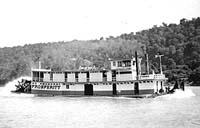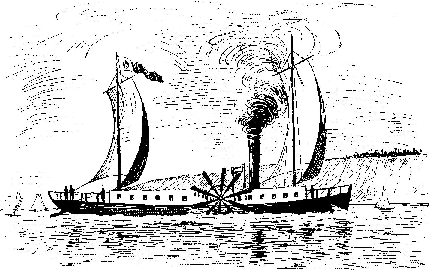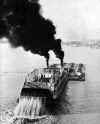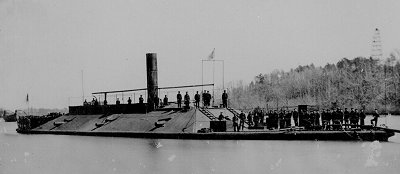|












RULE # ONE .... "Don't try to ever compare a
Towboat - With A TUG!"
"Its an Insult to
Both!! ..... Since Tugs are a totally different type of WORKBOAT and
can't do this work on Inland Rivers! ... A tug can only do some things
on a river, where its depths are deep enough to allow it to Operate.
But further upstream = Its the Domain of
TOWBOATS!
So, Just What The Heck - Is
A Towboat Anyway?
 Picture a workboat that's been built to
withstand the worst possible conditions imaginable for any vessel to
endure. Especially when running in a "Shallow Ditch", filled the
following ingredients = # One - You Have Damned Little Water ..... # Two
= Very Narrow Twisting Channels laid out by what must of been a Drunk'n
= SNAKE. # Three = Rivers are filled with Sandbars .... Rocks ....
Stumps & Mud as well as "Swift Currents" that can attain 15+ Mph. OR
MORE. Then Mix well with Crosswinds, Narrowly Spaced - Bridge Piers
... Low Bridges you can't get under and other navigation difficulties &
Obstructions. Then pour everything into one bowl and garnish with
plenty of - River Traffic. And you begin to get some idea of what a
river truly is. "And you also begin to see what these boats must do,
which is nothing short of = IMPOSSIBLE!"
Picture a workboat that's been built to
withstand the worst possible conditions imaginable for any vessel to
endure. Especially when running in a "Shallow Ditch", filled the
following ingredients = # One - You Have Damned Little Water ..... # Two
= Very Narrow Twisting Channels laid out by what must of been a Drunk'n
= SNAKE. # Three = Rivers are filled with Sandbars .... Rocks ....
Stumps & Mud as well as "Swift Currents" that can attain 15+ Mph. OR
MORE. Then Mix well with Crosswinds, Narrowly Spaced - Bridge Piers
... Low Bridges you can't get under and other navigation difficulties &
Obstructions. Then pour everything into one bowl and garnish with
plenty of - River Traffic. And you begin to get some idea of what a
river truly is. "And you also begin to see what these boats must do,
which is nothing short of = IMPOSSIBLE!"
.... But this says nothing
about "Extremes in Weather", like Hurricanes & Tornadoes
or Hail Storms with Hail bigger than Softballs. Yes,
a Towboat is truly born to a life of "Difficulty", raised in a realm
where no boat should ever be forced to Run. But to these boats, its
just routine on any river, when your born from their legacy of
steamboats. Designed to endure - Hell Itself! ..... Pushing massive
amounts of tonnage = Where No Other Vessel can roam. All this and
much more, created these river workboats, whom are capable of Churning -
Mud, Chewing Stumps & Surviving such encounters on a daily basis, 365
days a year, whenever cargo has to = Move!
___________________________________________________________________
Towboats
were Born From Steamboats
So Who Built
The 1st - Steamboat?
 Robert Fulton designed and built the very
first American Steamboat, in 1807. It was called the Clermont
and steamed it down the Hudson river from New Albany to
New York. But his - 2nd boat, built in 1811 along the upper Ohio
in Pennsylvania, called - "New Orleans" is much more important here.
Because that vessels launching is considered the beginnings of what
opened our nations western territory to more settlements. Because it
was the first steamboat to ply the Ohio, Mississippi river system.
And it opened our nation to much faster travel time. All thanks to
Fulton's invention as he
steamed it down
And back in those days, if you had to travel someplace, you
either used a Keelboat or Flatboat, Walked or Rode a Horse. And there
were only meager game trails to follow between towns & settlements. And
Indians were always a worry, along with Pirates and thief's - just to
mention a few common problems everyone shared in those days - when
traveling. So life was very dangerous, but also rather interesting
too. Case in point, take what the Indians - thought of steamboats,
for example. Many thought they were
a - Bad Omen and they called steamboats
... "The White Man's - "Fire Canoe!"
FACT! .....
By 1836, over "Six Hundred" steamboats
where traveling our inland rivers. And virtually no river or large
stream within our nations boundaries, at some point - in time, hasn't
been navigated by a steamboat. And news of "Custer's Last Stand" at
little Bighorn, was brought down the Missouri river with survivors of
the battle, aboard the steamboat - Far West. And back in those days,
steamboats could travel in as little as 18" of water. No wonder -
Mark Twain once said - The Steamboat is a Remarkable Thing, "Capable of
Moving on as little water - as a heavy Dew!
Robert Fulton designed and built the very
first American Steamboat, in 1807. It was called the Clermont
and steamed it down the Hudson river from New Albany to
New York. But his - 2nd boat, built in 1811 along the upper Ohio
in Pennsylvania, called - "New Orleans" is much more important here.
Because that vessels launching is considered the beginnings of what
opened our nations western territory to more settlements. Because it
was the first steamboat to ply the Ohio, Mississippi river system.
And it opened our nation to much faster travel time. All thanks to
Fulton's invention as he
steamed it down
And back in those days, if you had to travel someplace, you
either used a Keelboat or Flatboat, Walked or Rode a Horse. And there
were only meager game trails to follow between towns & settlements. And
Indians were always a worry, along with Pirates and thief's - just to
mention a few common problems everyone shared in those days - when
traveling. So life was very dangerous, but also rather interesting
too. Case in point, take what the Indians - thought of steamboats,
for example. Many thought they were
a - Bad Omen and they called steamboats
... "The White Man's - "Fire Canoe!"
FACT! .....
By 1836, over "Six Hundred" steamboats
where traveling our inland rivers. And virtually no river or large
stream within our nations boundaries, at some point - in time, hasn't
been navigated by a steamboat. And news of "Custer's Last Stand" at
little Bighorn, was brought down the Missouri river with survivors of
the battle, aboard the steamboat - Far West. And back in those days,
steamboats could travel in as little as 18" of water. No wonder -
Mark Twain once said - The Steamboat is a Remarkable Thing, "Capable of
Moving on as little water - as a heavy Dew!
___________________________________________________________________
Henry Shreve - PERFECTED
What Robert
Fulton = CREATED!
Fulton's -
trip to New Orleans, was closely watched by many, but none more closely
than by Henry
Shreve. Because he had prior "Keel & Flat-Boat", experience,
and realized there were flaws in Fulton's - steamboat design. And
this was proven as he watched Fulton encounter problems, common to all
vessels that run rivers. Simply put, Fulton's steamboat was simply
'To Deep" in draft for operating on rivers. Because when the boat
encountered a sandbar, its round hull would often roll over on its side
and take on water. Several times, the vessel nearly sank during the
trip south. Which gave Shreve ideas on how to improve things.
Returning to his home, he began
to develop his own steamboat designs, which used concepts from his
flatboat experience and created a whole new vessle.... The STERN
WHEELER!

Typical Mid-1800's Stern Wheel -
Steamboat
___________________________________________________________________
Where Did The Term = Towboat
.... COME FROM?

Late 1800's
"Converted" Packet Boat, used to Push - Barges!
The term -
TOW or Towboat, originates most likely from the first use of Barges on
our inland rivers. The barge ( Or a Number Of Them! ), when
"Lashed Together", were called a = TOW. So its not difficult to
figure out how this quickly formed the phrase - Tow Boat, as a shortened
version that combined steamboat & barges - Together. But this very
same term is also found in steamboats used to assist huge "Log Rafts",
to get downstream to saw mills too. So its exact origins and whom
exactly started its use = as a river term or phrase, just isn't
clear. However, by around 1820 ( We Believe ), pushing barges
had a good start on our inland rivers and since smaller steamboats were
built to run smaller rivers. They were used to handle an occasional
barge, to get extra cargo to its destination. The 1st barge, probably
made from an old Flatboat or keel boat, or maybe what was left of an
older gutted - steamboat hull, became the Barge. Nothing fancy -
that's for sure, so the early towboat was unlike its graceful
counterpart, the packet boat , because it need no fancy looks. It
only needed space for required supplies, firewood - for fuel, and the
barest basic's of sleeping quarters for its crew, some didn't even have
stateroom and you slept - On Deck. Simple - but also very unique, the
early towboat required only two things in its early beginnings, "More
Powerful Engines & Enhanced Steering, in order to handle more barges &
cargo. And that is exactly how these boats were improved as time went
by, making them more effective and better equipped to handle what seemed
impossible. Think Not? .... well how many boats can you name,
which are designed to withstand the rigors of Churning Mud & Chewing
Stumps, or Rocks and able to Survive a Grounding with little or no
damage? "To me - at least. these boats are nothing short of =
Remarkable!
___________________________________________________________________
The Sprague
Lovingly Called
"Big Momma", the
Largest Steam
Powered - Towboat .... EVER BUILT!
Tap
Photos to Enlarge





The
"SPRAGUE", was the Largest
and most powerful - steam towboat, that was ever built. And she still
holds towing records that continue to stand - today, and may well never
be broken. Built at Dubuque Iowa, by "Iowa Iron Works" in 1901, she
had a total of 2,079 Horsepower with a steel hull that measured 276' x
61' x 7.4' overall = length, width & draft. Carrying Six "Hopkins
Boilers" that powered her "Forty Foot" diameter stern wheel, the
sternwheel was later shortened to a 38 foot diameter to give her more
speed and power. This is also about the point, when she acquired the
nickname "Big Momma". Mainly due to the massive tows and cargo she
could handle, that were often so-massive in size, they caused the
Mississippi to actually run backwards after she passed going upriver.
Some accounts claim her "Wheel Wash" would often splash the banks - for
hours after she had passed. And having six - boilers to fuel, she
easily consumed coal in "Tons - Per Hour" rates, or by the truckload by
today's standards. All of which had to be hand fed to her boilers, by
a large number of crewmen with shovels and wheel barrows to haul the
coal from her Fuel Flats. Note the coal barges in the "Above - Left
Photo", their obviously just a small part of her fuel supply and
during a trip she'd have to carry a large number of those coal flats to
keep her steam - Up!
De-commissioned at Memphis Tenn. on March
5 of 1948, she was then laid-up at Vicksburg Mississippi and later
converted to a floating museum / tourist attraction. But the boat
burned in 1974 under mysterious conditions, which the cause of the fire
was never determined? Her remains now lay along the lower - Yazoo
River in one of its slack water creeks, a sad reminder of the KING -
OF PUSH and all that's left is these photos and her Legacy. NOTE
= the above - Left Photo, came from a postcard sent to me, by Mr. Jack
Custer, editor of the "Egregious Steamboat Journal" at Louisville Ky.
The photo on the Right - was found in my research in a museum photo
collection at the St. Louis - Mercantile Library. And the rest are
from various river museum collections. Just exactly "Where Or When"
these photos were taken ..."Or By - Whom?".... Was Never Determined!
_______________________________________________________________________
Steamboats = The 1st to use
"Duel Steering!"


Late 1800's Stern
Wheelers with usual = Flanking Rudders
Later Same Vessel, converted to "DUEL -
Steering Systems"
Going Up-River - Was Easy .... "Going Downstream with the Current" -
Was The Hard Part!
By the Late 1800's .... Shipbuilders & Owners (
even today ), were always trying to improve profits and give their boats
- greater speed & abilities. Duel Steering - was just one
these unique ideas, so successful it became a standard on all modern
river towboats. Yet nobody knows exactly whom - first developed
the idea?.....Or which vessel, was the first to use it?? But a
lot of old - River Rats ( At First ), thought the idea -
CRAZY. Which is probably where the term - Monkey Rudders, may well
have come from as they called them. Being a term which refers to the
"Stern Rudders" on towboats, which steamboats originally - didn't
have. Later these twin steering systems were called simply - Flanking
& Stern - Rudders, which in steamboats, at first = were all coupled
together - as one single system. This allowed a pilot to steer = in
either direction, using the engine = "Forward or Reverse", no matter
whether the vessel was going = Upstream Or Down. This way, pilots had
control, regardless of cross winds and currents, which made things - Far
More Safe, not to mention Easier to Handle!
___________________________________________________________________
Other Unique - Riverboat
Facts
 Worlds First - Steam
Powered Warships, Were American River - Gun Boats!
Packets or Steamboats used on river trade routes, were converted or
rebuilt for War - by both sides in the Civil War. This founded the
history of what became our "Modern Naval Warships" and the World
Followed our Path. The Monitor and others - like her, using
innovations that began back then. Proved other concepts and ideas
that also inspired today's modern shipbuilding, not only in War, but in
Trade and Cargo - Transportation. Take the change from Paddlewheels,
to the new idea of Propeller Drives & Other early Inventions in
Steamboats ..... Today's modern vessels are full of Historically
recorded fittings and New Fangled Ideas that became standards today
..... See More Below!
Worlds First - Steam
Powered Warships, Were American River - Gun Boats!
Packets or Steamboats used on river trade routes, were converted or
rebuilt for War - by both sides in the Civil War. This founded the
history of what became our "Modern Naval Warships" and the World
Followed our Path. The Monitor and others - like her, using
innovations that began back then. Proved other concepts and ideas
that also inspired today's modern shipbuilding, not only in War, but in
Trade and Cargo - Transportation. Take the change from Paddlewheels,
to the new idea of Propeller Drives & Other early Inventions in
Steamboats ..... Today's modern vessels are full of Historically
recorded fittings and New Fangled Ideas that became standards today
..... See More Below!
Tap Photo to
Enlarge
 The 1st US - Work Boat, to use a
Kort Nozzle!
Installed on the M/V Pioneer in 1939,
with a 93' hull that had carried 250 horsepower. This "Single Screw"
towboat was built by Dravo Shipbuilding, as an experiment. Just to
prove Kort Nozzles - worked on inland rivers, and Improved - thrust, by
as much as 25% - Or More. For example - if a 4800 horse towboat was
refitted with Kort Nozzles, it would operate effectively like a larger
5000 horse boat with the kort's =
added thrust.
This meant river boats with smaller engines could also use - less fuel,
equipped with kort nozzles and create more thrust & power that provided
owners a greater cost savings to operate.
The 1st US - Work Boat, to use a
Kort Nozzle!
Installed on the M/V Pioneer in 1939,
with a 93' hull that had carried 250 horsepower. This "Single Screw"
towboat was built by Dravo Shipbuilding, as an experiment. Just to
prove Kort Nozzles - worked on inland rivers, and Improved - thrust, by
as much as 25% - Or More. For example - if a 4800 horse towboat was
refitted with Kort Nozzles, it would operate effectively like a larger
5000 horse boat with the kort's =
added thrust.
This meant river boats with smaller engines could also use - less fuel,
equipped with kort nozzles and create more thrust & power that provided
owners a greater cost savings to operate.
Tap Photo to
Enlarge


 The Earliest - Most
Powerful Diesel ...Towboat!
Was the "Irvin S. Cobb", launched in 1936, from the rebuilt remains of
the old 1929 - steel hull of the Steam Towboat - J. N. Pharr. The
Cobb used a 615 horse - National Superior engine, the largest diesel of
its time. Turning a long drive shaft - mounted down the hulls -
center points, to beveled stern gearing that powered its Chain Driven -
Wheel. Called a "Bicycle Boat", for its unique chain drive system,
this vessel was also, one of the earliest boats fitted with an Elevated
Helm. Called a "Skyscraper - Helm", mounting its helm - much higher
to give added height and clear views over the unusually tall barges - it
pushed. These were multi-deck barges, loaded with new automobiles
from northern factories, the boat delivered south of this point. The
same barges where later used to haul Military Equipment ( Trucks,
Jeeps, Etc ), in support of the war effort, before it left service
sometime around 1940. These are just a few examples of the rich
heritage in historical documents that show how Steamboats and their
conversions, have built a legacy that still continues - today in Modern
Designed Towboats!
The Earliest - Most
Powerful Diesel ...Towboat!
Was the "Irvin S. Cobb", launched in 1936, from the rebuilt remains of
the old 1929 - steel hull of the Steam Towboat - J. N. Pharr. The
Cobb used a 615 horse - National Superior engine, the largest diesel of
its time. Turning a long drive shaft - mounted down the hulls -
center points, to beveled stern gearing that powered its Chain Driven -
Wheel. Called a "Bicycle Boat", for its unique chain drive system,
this vessel was also, one of the earliest boats fitted with an Elevated
Helm. Called a "Skyscraper - Helm", mounting its helm - much higher
to give added height and clear views over the unusually tall barges - it
pushed. These were multi-deck barges, loaded with new automobiles
from northern factories, the boat delivered south of this point. The
same barges where later used to haul Military Equipment ( Trucks,
Jeeps, Etc ), in support of the war effort, before it left service
sometime around 1940. These are just a few examples of the rich
heritage in historical documents that show how Steamboats and their
conversions, have built a legacy that still continues - today in Modern
Designed Towboats!
___________________________________________________________________
Last Updated On
06/29/23 .
With

|